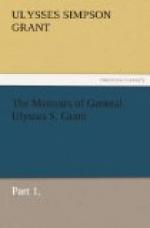General Taylor’s force was about six thousand five hundred strong, in three divisions, under Generals Butler, Twiggs and Worth. The troops went into camp at Walnut Springs, while the engineer officers, under Major Mansfield—a General in the late war—commenced their reconnoissance. Major Mansfield found that it would be practicable to get troops around, out of range of the Black Fort and the works on the detached hills to the north-west of the city, to the Saltillo road. With this road in our possession, the enemy would be cut off from receiving further supplies, if not from all communication with the interior. General Worth, with his division somewhat reinforced, was given the task of gaining possession of the Saltillo road, and of carrying the detached works outside the city, in that quarter. He started on his march early in the afternoon of the 20th. The divisions under Generals Butler and Twiggs were drawn up to threaten the east and north sides of the city and the works on those fronts, in support of the movement under General Worth. Worth’s was regarded as the main attack on Monterey, and all other operations were in support of it. His march this day was uninterrupted; but the enemy was seen to reinforce heavily about the Bishop’s Palace and the other outside fortifications on their left. General Worth reached a defensible position just out of range of the enemy’s guns on the heights north-west of the city, and bivouacked for the night. The engineer officers with him—Captain Sanders and Lieutenant George G. Meade, afterwards the commander of the victorious National army at the battle of Gettysburg—made a reconnoissance to the Saltillo road under cover of night.
During the night of the 20th General Taylor had established a battery, consisting of two twenty-four-pounder howitzers and a ten inch mortar, at a point from which they could play upon Black Fort. A natural depression in the plain, sufficiently deep to protect men standing in it from the fire from the fort, was selected and the battery established on the crest nearest the enemy. The 4th infantry, then consisting of but six reduced companies, was ordered to support the artillerists while they were intrenching themselves and their guns. I was regimental quartermaster at the time and was ordered to remain in charge of camp and the public property at Walnut Springs. It was supposed that the regiment would return to its camp in the morning.




